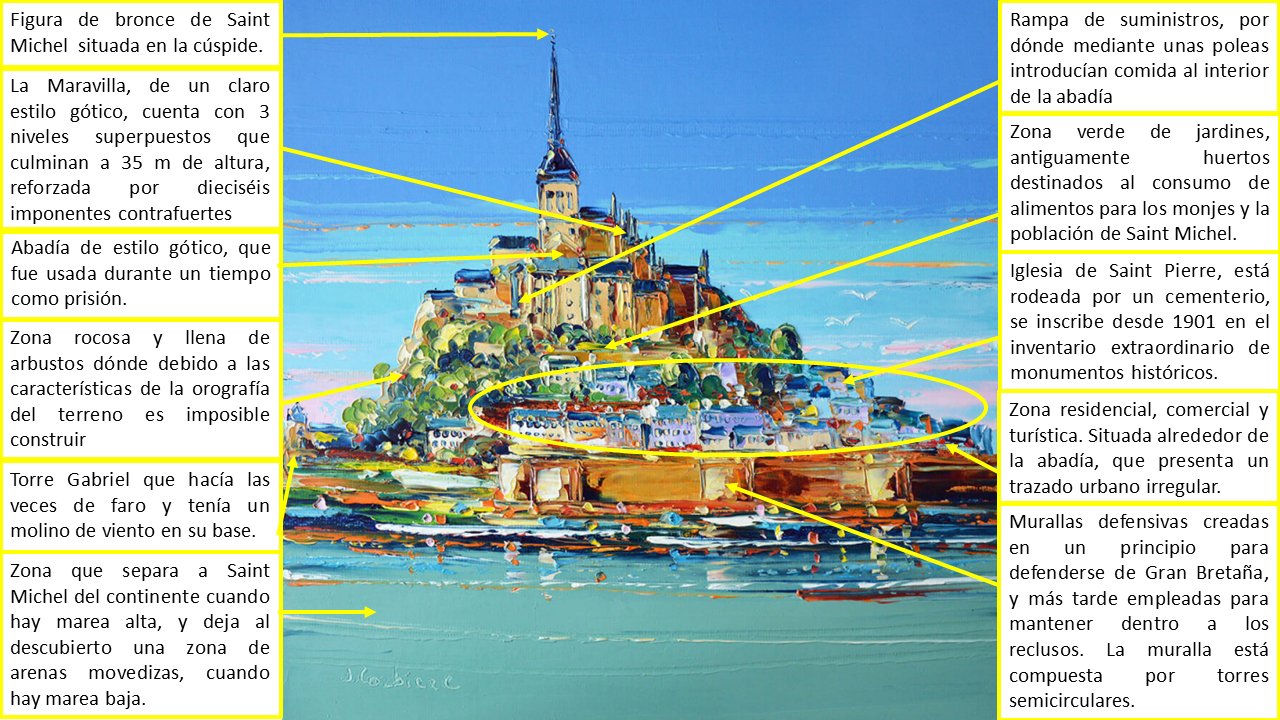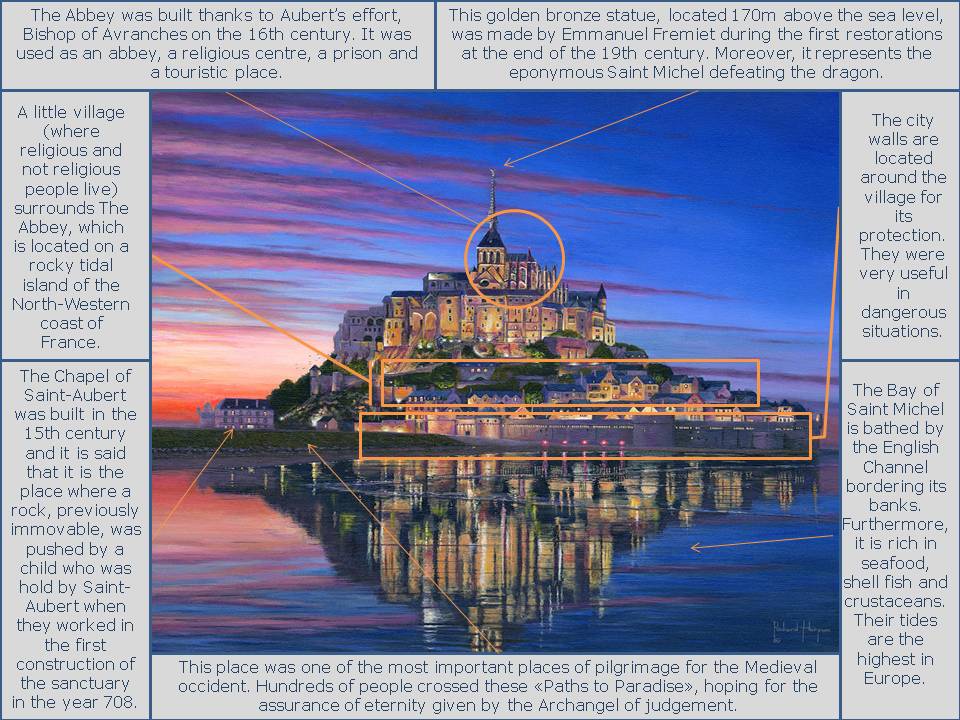LE MONT SAINT MICHEL (Liisa Corbière, 2019)
Este cuadro pertenece a una serie de óleos realizados por Liisa Corbière. En él representa en la actualidad el Mont Saint Michel, una pequeña ciudad amurallada situada en la comarca de Normandía. Esta artista de origen finés descubrió la zona de la Provenza de joven y se enamoró de sus colores y sus tonos cálidos, lo cual le sirve de inspiración para sus cuadros. Su estilo es impresionista, se centra mucho en los colores y la luz. Concretamente en este cuadro, se puede apreciar el reflejo del Mont Saint Michel en el agua del mar y los colores brillantes y luminosos del cielo. Si nos fijamos un poco más en el cuadro podemos observar que la ciudad ha sido retratada durante la marea alta ya que está rodeada de agua por completo.
Este cuadro se puede encontrar en Carré D’artistes, una página web de una galería de arte, que a su vez incluye otras más, que promueve el arte de la zona de la Provenza y la cultura francesa. Además, su galería online presenta más de 100 artistas que exhiben en ella permanentemente, de manera rotativa, lo que les permite darse a conocer como artistas.
Mont Sant Michel está emplazada en el Mont Tombe, un pequeño monte situado en medio de la bahía de Saint Michel. Este sitio es muy especial, ya que se trata de un terreno que en ocasiones se queda aislado, lo cual se debe a las mareas, las cuales son las mayores de Europa; ya que la diferencia entre la marea alta y la marea baja es de unos 15 metros, lo cual provoca que entre la pleamar y la bajamar el mar pueda retirarse unos 15km hacia el continente o viceversa, lo que convierte en ocasiones al Mont Saint Michel en una especie de “islote”.
El nacimiento de Mont Saint Michel tiene un halo de espiritualidad, ya que según cuenta la leyenda, el arcángel San Michel pidió a al obispo Aubert en torno al 708 que cree un santuario en este emplazamiento, así que éste lo mandó construir en su honor. Más tarde en el 966 una comunidad de monjes benedictinos se establece en él y éste se convierte en uno de los lugares de peregrinación más importantes de la época medieval. Además, en esta época el Mont Saint Michel era conocido como la “Ciudad del libro” lo que se debe a la cantidad de manuscritos que se copiaban en su abadía. Esta ciudad posee numerosos estilos de arte arquitectónicas (románico y gótico principalmente), lo cual se debe a que se empezó a construir en el siglo X, pero se ha ido restaurando y modificando hasta el siglo XIX.
Como se puede observar, esta ciudad posee un trazado urbano irregular, con callejuelas pequeñas con recovecos, debido a que se empezó a construir en la Edad Media y debido también a la topografía que presenta, ya que está situada en un monte. Como se puede apreciar en la imagen, la ciudad posee una estructura dividida en tres partes: una primera zona alta, dónde se encuentra la abadía, una segunda zona baja, dónde se encuentra el asentamiento y una tercera zona extramuros, dónde hay un pequeño embarcadero, una parada de autobús y un aparcamiento para coches. Podemos distinguir en el centro de la ciudad, en la zona alta, la abadía de San Michel, santuario construido en honor al Arcángel, más tarde convertido en abadía, el primer edificio que se construyó en la ciudad; el cual presenta en su zona más alta una figura del Arcángel. En esta abadía hay numerosos estilos arquitectónicos plasmados, ya que fue reconstruida en varias ocasiones; sin embargo, en la zona de la Maravilla, nos encontramos con un estilo claramente gótico, de hecho, es la mayor obra del gótico normando. En torno a la abadía se emplazan viviendas y comercios construidos a posteriori, hoy en día en esta zona también podemos ver además de los jardines, museos y comercios. A su vez, podemos distinguir en un extremo la Capilla de Saint Aubert, dedicada al obispo y primer constructor de Mont Saint Michel. También se puede apreciar que cuenta con una sólida muralla, esto se debe a que esta ciudad se situaba en la frontera entre Normandía y Bretaña, además de servir como defensa frente a Gran Bretaña en la Guerra de los 100 años. Más tarde se instalaron nuevos monjes y reacondicionan la zona para permitir nuevos peregrinajes. También se empleó a posteriori como cárcel para la reclusión de presos políticos. En 2001 fue declarada Patrimonio de la Humanidad por la UNESCO. Por lo que hoy en día el Mont Saint Michel se emplea para turismo, aunque aún residen algunos monjes en su abadía.
Aitana Llorente Sánchez


